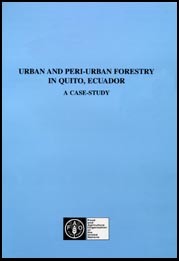
by
Sharon Murray
Forestry Department
Food and Agriculture Organization of the United Nations
Rome, 1997
|
The designations employed and the presentation of material in this publication do not imply the expression of any opinion whatsoever on the part of the Food and Agriculture Organization of the United Nations concerning the legal status of any country, territory, city or area or of its authorities, or concerning the delimitation of its frontiers or boundaries. |
All rights reserved. No part of this publication may be reproduced, stored in a retrieval system, or transmitted in any form or by any means, electronic, mechanical, photocopying or otherwise, without the prior permission of the copyright owner. Applications for such permission, with a statement of the purpose and extent of the reproduction, should be addressed to the Director, Information Division, Food and Agriculture Organization of the United Nations, Viale delle Terme di Caracalla, 00100 Rome, Italy.
© FAO 1997
This electronic document has been scanned using optical character recognition (OCR) software and careful manual recorrection. Even if the quality of digitalisation is high, the FAO declines all responsibility for any discrepancies that may exist between the present document and its original printed version.
1.1. Urbanization in the regional context
1.2. Social and environmental outcomes of urbanization in Latin America
1.3. Objectives of the case study
2.1. Urbanization in Ecuador
2.2. Delimiting the urban socio-ecosystem
2.3. General characteristics of the urban socio-ecosystem in Quito
2.3.1. Biophysical characteristics
2.3.2. Social and economic characteristics
2.3.3. Legal and institutional characteristics
3. THE URBAN FOREST ECOSYSTEM IN QUITO: POTENTIAL AND LIMITATIONS
3.1. The existing urban forest ecosystem
3.2. Potential for additional vegetation in the urban forest ecosystem of Quito
3.3. Functions of the urban forest ecosystem
4. URBAN FORESTRY IN QUITO: RECENT AND CURRENT ACTIVITY
4.1. Urban forestry management in Quito prior to 1990
4.2. Urban forestry management in Quito 1990-present
4.2.1. Major issues in management of the urban forest ecosystem in Quito
4.2.2. Major social actors involved in urban and peri-urban forestry in Quito
5. CONCLUSIONS AND RECOMMENDATIONS
APPENDIX A: HISTORY OF LAND USE PLANNING IN QUITO
APPENDIX C: PLANT SPECIES CURRENTLY FOUND IN THE URBAN AND PERI-URBAN ECOSYSTEM OF QUITO
APPENDIX D: SUMMARY OF PUBLIC AND PRIVATE ACTORS IN THE URBAN FOREST ECOSYSTEM IN QUITO